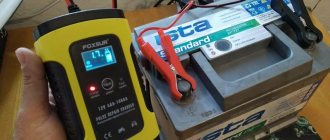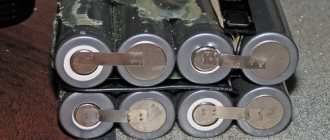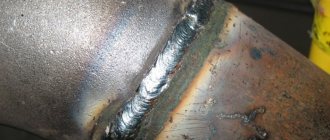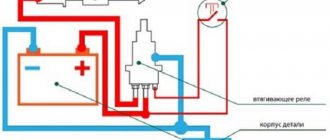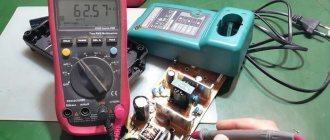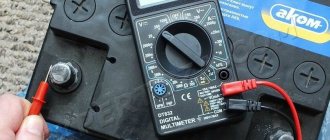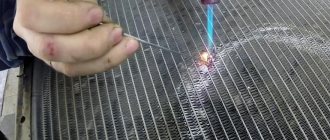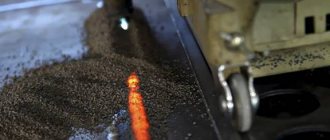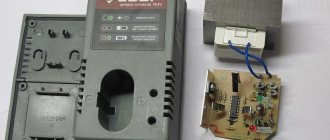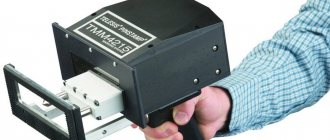Home / Devices
Back
Reading time: 3 min
0
1836
Equipment for welding work of inverter or transformer type is necessarily present among the home equipment of specialists in this profile. Welding units have long been no longer an attribute of the pros.
Anyone interested can purchase it and do small home welding tasks. Welding equipment is easy to use.
There is no need to study welding for a long time in order to weld what is required at home. Turning on the welding machine is generally easier than ever. Find a suitable electrical outlet. Turn on the welding cord.
- Introductory information
- Is it possible to cook using a car battery?
- Own experience of cooking from a car battery
- Is it worth welding from a machine battery?
- Safety regulations
- Summary
Introductory information
In theory, everything seems much simpler. But in application, certain conditions must be met. The current in the electrical network must remain uninterrupted and not fall below 180 Volts.
Or your welding unit must cope with low voltage work. Such equipment is not cheap.
It is not even discussed that you must have access to electricity. But some country houses and dachas, garages located far from the urban area are not connected to electricity.
What to do in this case. Our opinion comes down to buying a fuel generator for welding. But not everyone wants to spend extra money, especially if you rarely use welding.
The correct option under such circumstances is to use a 12-volt car battery. Some specialists manage to connect the battery to a welding inverter.
Even to carry out non-long-term welding. In our review we will write whether it is possible to carry out welding tasks using a 12 Volt battery. Is it really necessary to take such risks?
Advantages and disadvantages
Gas shielded welding diagram.
All these processes have their advantages and disadvantages, so the practical use of batteries for welding depends on specific conditions, financial capabilities and the availability of necessary materials. The positive points include the following:
- Ability to carry out welding work in extreme conditions. For example, on the road, in the field, etc.
- Possibility of welding in the absence of specialized equipment. However, in the absence of an inverter, only non-ferrous metals can be welded.
- No voltage drops in networks. Since the process is carried out using an autonomous energy source, it does not harm the operation of the network.
- Ability to work under almost any external conditions. If the equipment is properly connected, welding can occur in hot or cold (temporary), during precipitation, etc. To do this, it is necessary to strictly follow certain rules for performing such work.
- Dead batteries can be reused after recharging.
However, this process has a number of disadvantages:
- The main disadvantage is the rapid discharge of the battery. Therefore, it is very important to monitor its capacity. To do this, a measuring device is installed in the circuit.
- Intensive discharge of batteries significantly reduces their service life. Therefore, it is necessary to constantly monitor the battery’s ability to hold a charge and replace batteries that do not hold a charge.
- Financial expenses. If only one car battery is needed for spot welding, then for welding with carbon electrodes or to connect an inverter, a minimum of three batteries are required, which are connected in series.
- Many people, when using batteries for welding, often neglect safety rules. However, despite the apparent simplicity of such work, it is possible to receive various injuries when performing it.
Is it possible to cook using a car battery?
Is it possible to carry out welding work using a 12 Volt battery? All owners of remote country houses and garages where there is no electricity are thinking about this. The mains current simply may not be enough to operate the inverter equipment.
This point is the subject of controversy. Of course, you can take the battery from your car, charge the welder, then return it to its place.
But additional questions arise. How good and strong the weld will be. Will the weld burn out? Will the battery itself deteriorate?
Based on our own experience, we declare that it is possible to cook using a 12-volt car battery. We will not say that machine batteries are suitable for powering a welding unit.
But they will be good additional insurance for these purposes. Car batteries have a large power reserve. Theoretically, they can charge a low-power welding inverter.
Capacitor welder circuit
Now the circuit: a switch in the power supply discharges the capacitors after completion of work and before shutting down. The capacitors are charged to 36 V and during the first charging phase the light in the 24 V 55 W power supply slowly lights up. After the spark, it also lights up and protects the power source during a short circuit of the electrodes. After obtaining a weld and leaving the electrodes from the battery, the capacitors are charged.
In general, the cost of the project was only 1000 rubles for capacitors. The remaining items could not be priced because they were in the house's inventory.
Although, of course, it would be nice to use an adjustable stabilizer to charge the capacitors to a certain voltage. Later we will add a welding readiness indicator after charging the capacitors.
Own experience of cooking from a car battery
We will look at our own experience of using a car battery to power an inverter unit. You can test it yourself and duplicate our work to verify what you have received.
It should be noted that one regular car battery will not be enough. Know this is a fact. At first we wanted to power the inverter from one car battery.
Welding was carried out at low current, using electrical connections 2 mm thick. The arc hardly ignited. The seam went with considerable effort. Then they took out two car batteries and connected them one by one.
Spot welding
Spot welding diagram.
Spot welding using a battery is considered the most primitive. To complete this you will need one battery, wires, and a pair of terminal blocks. But let's take a closer look
Before performing welding work (this applies not only to spot welding), it is necessary to follow some safety rules. The first is eye protection. Naturally, in field conditions a person will not have a welding shield (mask), just as most car enthusiasts do not have one in garages. However, sunglasses can provide minimal protection during short-term work. The next important point is the insulation of the wires. It must be intact and not collapse. Since such welding work requires a current of at least 150 amperes, it is necessary to protect yourself from electric shock. Lastly, as when performing any complex work, attentiveness and accuracy are required.
To assemble a spot welding device, it is necessary to connect insulated wires with a cross-section of at least 5 mm to the battery terminals (the choice of cross-section depends on the battery current), the correct selection of the wire cross-section is monitored during operation - the wires should not get hot. The wire leads should be connected to a terminal block (Soviet BZN will do) with a rated current of about 200-250 amperes. Next, wires are connected to the terminals, which will serve as electrodes. They must be rigid, their cross-section must coincide with the cross-section of the output wires, and they must be insulated. Next, their terminals are placed at a distance of up to 3 mm from each other (however, they should not be in contact) and the wires are fixed in this position with improvised materials (household feed-through terminals are well suited for fixing). The ends of the wires are stripped of insulation, and the device is ready for use.
To weld 2 parts, they should be connected to each other, and the cleaned wires of the device should be attached to the connection point on one side. Important: for welding, only the ends (section) of the wires are applied, and it is necessary to ensure an even cross-section of each wire (for this, the i.x is equalized with a needle file).
Is it worth welding from a machine battery?
The welding process from a 12 volt car battery is real. We advise using this method only in exceptional cases. The only advantage of this method is welding outside the home. And there are many more disadvantages.
The biggest problem is the almost uncontrollable voltage when welding from a car battery. Batteries may increase the initial voltage reading, so you will not be able to calculate the actual voltage numbers.
It's uncomfortable. Such differences contribute to defects in products that you cannot influence.
Also, due to uncontrolled voltage, the welding unit will burn out very easily. Our inverter equipment remains intact.
But if you use it awkwardly, you will be left without three batteries and a welding unit. In this case, be prepared for excessive consumption of electrical conductors.
In addition, when using the auto battery to fuel welding work, it is no longer worth putting it back in the car. Better to play it safe.
The eternal question is whether it's worth it. Only if you urgently need to work with welding equipment, but there is not the slightest chance of getting power from a regular outlet.
If you have extra money, it is better to buy a fuel generator. You will be able to organize the process not only with a welding unit, but also successfully connect other electrical tools. This is the best best way out of the situation.
So don't stress and buy a fuel generator. You can choose a small-sized and low-power option. It will easily fit in the trunk of your car.
You will transport it without much effort. They are very economical in fuel consumption and can operate for a long time. The generator can cope with ensuring the operation of the entire arsenal of your power tools.
Brief description of welding methods
Classification of types of welding.
People who weld quite often regularly face the problem of voltage drops in networks under high welding loads, which occurs both when using old welding transformers and new inverter machines. Often, when connecting welding devices, the voltage drops by at least 30 Volts. Such a drop is serious and may affect the operation of household appliances.
Therefore, before starting welding work, according to the legislation of the Russian Federation, it is necessary to warn all neighbors who are powered from the same line. This creates a lot of inconvenience, and neighbors may refuse to carry out such work. The way out of this situation is battery welding.
When and where it first appeared is unknown, but the first documented (filmed) process was in the 60s of the last century.
The authors are Soviet polar explorers who traveled to the site in cars.
The physics of this process is no different from conventional welding. Just like ordinary welding, welding from a battery occurs when an electric arc is formed. In this case, a permanent welding connection also occurs at the molecular level - the heated metal begins to melt, forming a seam.
Assembly diagram of a welding machine for soft welding.
At the moment, such welding can be performed in three ways (conditional division):
- Spot welding using bare contact wires. Requires a minimum of preparation, materials, and labor costs. It happens very quickly, the connection is much weaker than a conventional weld. During such welding, copper wires will protrude as electrodes.
- Connecting multiple batteries to a battery pack. This will allow welding work to be carried out using carbon electrodes of small diameter (up to 3 mm). In this case, the diameter of the electrode depends on the maximum current supplied by the battery.
- Connecting several batteries into a battery and connecting an inverter welding machine to it. In this situation, welding work is carried out as standard, only the power source changes.
The choice of welding method depends on the materials of the parts being welded. Thus, the connection of non-ferrous and alloyed metals must be performed by spot welding (point 1) or carbon electrodes (point 2).
Ferrous metal connections are made only with welding inverters (point 3). Inverters can also weld non-ferrous metals, but since the welding process using inverters is not new, there will not be a detailed description here. The only thing worth noting is the need to connect 3-4 batteries of the same capacity and the same output current into one battery. It is worth noting that the inverter quickly drains the battery from which it is powered. Therefore, it is necessary to constantly monitor the charge level by connecting a measuring device to the battery.
Safety regulations
In appearance, the car battery is absolutely safe. All its parts are inside a strong case. This impression is deceptive.
You should not be negligent about the safety rules when using car batteries. Moreover, when ensuring the operation of the welding inverter.
If you want to remove the battery from the car, move it or perform any actions, use special gloves. The most correct and safe option is also special clothing for these purposes.
But if this is an unplanned event, you are unlikely to follow her. Therefore, we will limit ourselves to thick gloves.
If electrolyte has dripped onto an open area of your body, you should immediately rinse the area. This area can be treated with a solution of soda or ammonia diluted with water.
Remove gloves and wash your hands well with soap. Don't eat near batteries, don't smoke, and generally be careful. If you are tired and need to take a break, place the car batteries in an isolated room and you should go out.
If your car batteries become dusty, they need to be cleaned. This is done using ammonia diluted with water. Use a clean, dry cloth.
If you have removed the batteries from your car, clean the plugs to ensure there is no dirt left behind. To prevent the formation of excessive gas pressure.
Remember that car batteries can become a threat to your health. When working with your car's battery, take good care of your body and mucous membranes from damage by acid.
You may get a serious burn. You should definitely have a fire extinguisher in your garage. If handled incorrectly, problems can also occur with welding equipment.
These are absolutely simple safety rules. But not all masters remember this when they start working with devices. Remember that it is better to prevent problems from arising than to eliminate the consequences later.
What is important to know
An important point is the choice of wire. If its cross-section is too large, you risk burning your batteries. Therefore, we strongly recommend using wires with a small cross-section, because it is better if the wire itself burns out (it is cheaper to replace it).
You can adjust the current strength (A) depending on the cross-section and length of the cable. The optimal length is 1 meter and cross-section 12 mm2. But, if you are making such a homemade product for the first time, try using a wire of a smaller cross-section, this will avoid possible problems.
Remember! It is prohibited to handle the electrode or wire with bare hands. Try using any available means that will help avoid direct contact.
From a transformer
Spot welding for batteries can be done with your own hands from a transformer. It can be used to weld not only batteries, but also any thin metal products.
To weld batteries, a high-power transformer is not required; 300-500 W is sufficient. The main thing is to be able to rewind the secondary winding.
The primary winding should be 220V 50 Hz. As a winding wire for the secondary winding, you need to use an insulated copper wire of large diameter. It takes three to four turns.
The body of the spot welding machine can be made of plexiglass or plywood. Plexiglas is of course preferable. The base of the housing must be of such a size that it can accommodate a transformer with connecting wires, a button and a lever with electrodes .
The lever is mounted on an axis between aluminum corner posts, which in turn are secured to the base of the device with self-tapping screws. The length of the lever is made in such a way that the electrodes attached to it reach the working platform of the base of the device. The diameter of the electrodes should be 3-5 mm. Their ends are sharpened and the ends are leveled.
The secondary winding of the transformer is connected to the electrodes using a stranded copper wire with a cross-section not less than the cross-section of the electrodes. The length of the wires from the secondary winding to the working part should be minimal. It is better to weld the connections to reduce the circuit resistance or connect them through screw terminal blocks.
The operating button is installed on one of the terminals of the secondary winding. Springs are installed on the lever and button. They are needed for their rapid return to their original state.
To set a specific welding pulse duration, instead of a button, you can use a thyristor or a power relay controlled by an RC circuit. The resistor must be variable, and the capacitor must be large enough to allow the pulse duration to be varied in the range from tens to hundreds of milliseconds.
There are a large number of circuit implementations of spot welding for batteries. Much depends on the materials available. Circuits may change to increase the functionality of the device and improve its consumer properties, but the essence remains the same.
Electrode welding
To perform such welding, it is necessary to connect 3 or more car batteries into a battery. Connections are made with large cross-section wires. Wires with powerful crocodiles at the end are connected to the battery terminals. Crocodiles act as clamps. One clamps the electrode, the other clamps the working part.
The further process is carried out similarly to conventional welding. It is important not to use thick electrodes (maximum cross-section - 3 mm). You should be careful when working, since crocodiles have a large uninsulated surface area.
